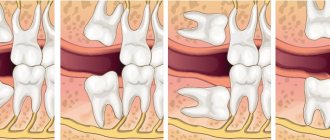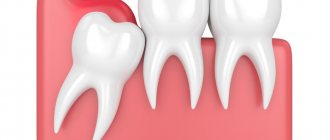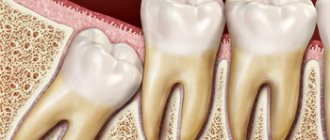A wisdom tooth is the 8th tooth in a row (figure eight) or 3rd molar, its eruption period is 17-25 years. This is a large molar, often with a complex root system. The peculiarities of its development and growth in most cases become the cause of various dental problems. Although the structure of the figure eight is characterized as an ordinary molar, its chewing function is practically absent. If a wisdom tooth hurts, it is rarely preserved. The figure eight is destroyed early, often erupts with a carious lesion, grows at an angle or in a horizontal position.
How can you tell if your wisdom tooth hurts?
Eights erupt much later than all the other teeth in the row, when the dentofacial apparatus is fully formed, and there is simply not enough space for a beginner. Due to the density of the gums and bone tissue, eruption is quite painful, accompanied by inflammation of the gums and damage to neighboring units. Pain during wisdom tooth growth is quite specific:
- Spreads along the jaw, extends to the temple, neck, head, ear, throat;
- around the figure eight there is swelling and redness of the gum tissue;
- due to pain and sore throat, swallowing is difficult;
- numbness of the jaw and severe pain indicate that the 3rd molar is growing crookedly, injuring the jaw nerve;
- it is difficult to open your mouth, especially if the wisdom tooth grows in the opposite direction from the jaw.
Each similar symptom indicates the presence of problems with the 3rd molar. You can temporarily relieve pain when wisdom teeth erupt with an analgesic. If the figure eights grow crookedly, the bite is disturbed, the cheek or gums are injured, they form in the bone tissue without erupting to the surface or appear only partially - they must be removed.
A wisdom tooth grows into the cheek: what to do
There are many cases when a wisdom tooth grows to the side, for example, towards the cheek. These teeth are not efficient in terms of chewing food, but they are excellent at chewing the mucous membrane of the cheek. By the way, in dentistry there is the concept of “dystopic wisdom teeth.” They are understood as fully erupted eighth teeth, but which occupy an incorrect position in the dentition, for example, have a buccal position (see figure below)
Wisdom tooth growing into cheek: photo
If your wisdom tooth is cutting into your cheek, pay close attention to it. Constant chronic injury to the buccal mucosa will first necessarily lead to the development of ulcers and inflammation. But that is not all. Constant injury to the oral mucosa is a predisposing factor for the development of hyperkeratosis, leukoplakia, and benign neoplasms. The sharp edges of fillings and dentures can have the same effect if they injure and rub the mucous membrane. We hope that our article: What to do when a wisdom tooth grows and your gums hurt – was useful to you!
Sources:
1. Dental education of the author of the article, 2. Based on personal experience as a dental surgeon, 3. National Library of Medicine (USA), 4. “Pathology of wisdom teeth eruption” (Rudenko A.), 5. “Qualified removal of third molars” (Asanami S.).
Why can a wisdom tooth hurt?
- Non-standard eruption
- impacted teeth formed in the jawbone, not erupted completely or partially, can be positioned horizontally or vertically. When the figure eight is placed on the side, it puts strong pressure on neighboring units, causing acute pain. - Gum hood
– dense gums can prevent teething; a “hood” of mucous tissue forms over the wisdom tooth. Bacteria and food particles begin to accumulate under it, which cannot be removed when brushing your teeth. This area is constantly injured, inflamed, and painful. An acute inflammatory process often develops into a purulent one. - The molar is rotated
around its axis - the more pronounced the rotation, the stronger the impact on the dental nerve, which causes pain in the molar itself, the adjacent unit or the entire jaw. - The cheek hurts
due to a wisdom tooth if it grows in its direction. The pain intensifies when chewing, the mucous membrane of the cheek is constantly injured and inflamed. - Caries
- the localization of the 3rd molar makes it difficult to care for it; often it is cut already with carious lesions of hard tissues, which causes pain. The sensitivity of the tooth increases, it reacts painfully to temperature and chemical stimuli. - Cyst
- due to systematic injury to the gum tissue, the molar itself, a cystic formation may form at the neck. A wisdom tooth cyst is often accompanied by serious complications - inflammation of the periodontal tissues, pericoronitis, abscess, and destruction of bone tissue.
Also, the reason that the wisdom tooth began to hurt are various dental pathologies - pulpitis, periodontitis (acute, chronic), periodontal disease. Removing the figure eight is not always justified; the doctor decides this issue individually, depending on the clinical picture. First, a comprehensive diagnosis is carried out, the doctor determines the location of the roots, assesses the condition of the jaw bone, gums around the figure eight, and the entire dentofacial apparatus.
Complications associated with the eruption of wisdom teeth
A wisdom tooth has been pulled out, the jaw hurts, these are sure signs of alveolitis
The lack of a professional approach to treating the problem can lead to certain problems in the future. The inflammatory focus in the retromolar area can spread and affect both soft and hard tissues.
The main complications of pericoronitis and general eruption of the figure eight are:
- Retromolar periostitis. This is an inflammatory process that forms in the periosteum behind the wisdom tooth. It manifests itself as a rise in body temperature, general malaise and severe pain. The pathological process spreads especially quickly to the area of the larynx and palate.
- Osteomyelitis of the jaw. May be a complication of periostitis. This damage to bone tissue is very dangerous; it can lead to purulent exudate entering directly into the bloodstream. This will lead to the formation of sepsis. Osteomyelitis is manifested by severe pain, significant swelling of the maxillofacial area, a rise in body temperature to critical levels, general malaise and discomfort.
- Abscesses and phlegmons. These complications are a purulent inflammatory process of the soft tissues of the face and neck. Abscesses and cellulitis can develop in a short period of time, in the absence of the necessary treatment. They spread quickly, capturing new areas. Like osteomyelitis, these inflammatory processes can lead to blood poisoning.
If the appearance of a wisdom tooth is accompanied by severe pain and discomfort, this is a sure signal to visit the dentist. Of course, you shouldn’t endure the pain; modern medications help relieve it for a long time, but not indefinitely.
It must be remembered that the appearance of pain is associated with an inflammatory process or some complication. Therefore, self-therapy can be carried out only to eliminate unpleasant sensations and prevent the progression of the pathology.
Indications for removal
- Pathological eruption of the figure eight (partial or complete retention, dystopia), accompanied by pain, chronic inflammation of the gums, destruction of adjacent molars, malocclusion, damage to the jaw joint and other problems;
- 3 molar has erupted outside the dentition, leading to crowding;
- inability to carry out treatment or prosthetics due to limited access to the dental unit;
- the presence of complications - cysts, granulomas, periostitis, periodontitis;
- orthodontic treatment - figure eights must be removed if they interfere with the installation of a corrective apparatus or prevent the teeth from taking the correct position when correcting the bite.
Danger of condition
Incorrectly erupting figure eights pose a threat not only to the oral cavity, but also to the body as a whole. Untimely assistance from specialists leads to blood infection. The infiltrate that has been in the oral cavity for a long time does not find a way out and breaks out. The tissues of the neck and jaw have a loose structure, which contributes to the rapid spread of pathogenic flora from the head down. In advanced cases, the situation is life-threatening.
The photo shows dental phlegmon - a common complication of untimely professional dental care.
Another danger posed by an erupting wisdom tooth is malocclusion. Due to an incorrectly positioned unit, other elements in the oral cavity are also displaced. Malocclusion leads to inadequate chewing of food, distortion of diction and aesthetic defects. Insufficient grinding of food products leads to dysfunction of the digestive organs. Aesthetic defects cause prolonged depression and neurological problems in the patient.
If the figure eight grows into the cheek, then injury to the mucous membranes of the mouth is possible. Chronic non-healing ulcers appear on their surface. Microdamages cause pain to a person with every meal and conversation.
To prevent the development of consequences, you should consult a doctor 1-2 days after the onset of dangerous symptoms. The doctor will decide the future fate of the wisdom tooth after examining the oral cavity, analyzing the patient’s complaints and studying the x-ray.
If a wisdom tooth grows for a long time and hurts, then intoxication of the body is possible, manifested by nausea and increased body temperature. The patient's condition worsens and it becomes difficult for him to cope with daily activities.
When do you need a doctor's help?
If the figure eight hurts, you should immediately consult a dentist. Consultation with a specialist is also necessary for pain of unknown etiology - squeezing, spreading over the entire jaw, occurring when chewing or opening the mouth. After examination and diagnosis, the doctor will decide what to do next with the molar. If the growth of a wisdom tooth is accompanied by swelling, redness of the gums, and acute pain, the doctor will prescribe anti-inflammatory therapy.
If eruption is difficult due to the gingival hood, an operation will be performed to excise it and drug therapy will be prescribed.
How long does a tooth hurt when there is a complication?
If the wisdom tooth does not grow in the required 60 days, something did not go according to plan. And in such cases, when talking about timing, dentists do not undertake to give any forecasts. Perhaps, with careful adherence to oral hygiene and constant monitoring by a doctor, the third molar will still grow in the near future.
But there is no less chance that the process will become chronic. Millions of people around the world experience excruciating exacerbations for years. The pain subsides for a while, but after a couple of months, and sometimes a couple of years, the tooth begins to cut again, and the pain returns with renewed vigor.
Wisdom teeth removal methods
The intervention tactics depend on the location of the 3rd molar, the degree of exposure to the gum surface, the number of roots, their confusion, and the position of adjacent teeth. Removing figure eights on the upper jaw is easier than on the lower jaw. This is due to the structure of the jaw tissue - the maxillary bone is looser, more airy, the mandibular bone is more massive and dense. Additionally, mandibular eights tend to have more tangled and developed roots.
According to the clinical picture, removal can be simple or complex. A simple extraction is performed like any other extraction - the molar is rocked with forceps and removed from the socket. Complex technology includes:
- gum incision;
- drilling a molar or sawing it into fragments;
- removing each fragment one by one;
- suturing the wound.
Stitches are removed on days 5-7
after the intervention (self-absorbable suture material can be used). The operation is performed under local anesthesia; removal under sedation (during medicinal sleep) is possible.
Treatment of wisdom teeth during pregnancy has its own nuances. Usually, the doctor limits himself to conservative therapy aimed at eliminating pain and inflammation. If possible, removal is performed after childbirth. The operation is carried out according to strict indications, if the inflammation has become purulent and threatens the health of the mother and child. For anesthesia, special drugs are used that are safe for the fetus.
At the RUTT clinic, the removal of a wisdom tooth with a complex root system and location is performed by experienced maxillofacial surgeons. This eliminates surgical complications - extensive trauma to the bone structures of the jaw, perforations, wandering root remains, postoperative fistulas, osteomyelitis, etc. Only maxillofacial surgeons have enough skills and experience to perform such interventions without complications.
Get rid of pain quickly and forever
In 60% of cases, the growing wisdom tooth is positioned incorrectly. Usually its inclination is oriented towards the second molar. This is the main reason why pain occurs.
To get rid of these problems, many people first of all use various remedies at home. Such remedies have a positive effect, but it is necessary to understand that self-help should not turn into long-term treatment, since it cannot completely get rid of the problem.
Traditional methods of emergency care for the appearance of “eights”
Stomatofit can replace many folk remedies
They mainly involve the use of decoctions and tinctures of medicinal plants.
The most effective and efficient means are the following:
- Sage herb. To prepare a decoction, pour two tablespoons of the product into 0.5 liters of boiling water and leave for 1 hour. Before use, it is necessary to strain the resulting broth and warm it slightly. It is recommended to rinse as often as possible during the day and especially after meals.
- Oak bark decoction. This product has a bactericidal effect and can eliminate swelling and inflammation. Prepared by brewing 6 tablespoons with 0.5 liters of boiling water. Then put on low heat and leave for 10-15 minutes. For the best effect, you can add a tablespoon of finely chopped sage herb.
- Black turnip decoction. 2-3 tablespoons of the crushed product are added to 0.5 liters of water and boiled for 15-20 minutes. It is recommended to rinse as often as possible during the day.
- Soda and salt. If you do not have the necessary medicinal herbs, you can use regular baking soda and table salt. A solution is prepared from these ingredients by adding one teaspoon of both substances to 200 ml of water.
Medications
To eliminate the pain reaction from the inside, you can take drugs such as Ketorol, Ketanov, Nise or Nurofen. These products allow you to relieve discomfort for up to 5 hours.
Do not exceed the dosage recommended by the instructions. Excessively large amounts of the drug can lead to general poisoning.
Basic painkillers for wisdom tooth pain
Attention!!! If there is no desired effect from the drug to relieve the pain reaction, you should not increase the frequency of use. The best option would be to replace it with an alternative medicine.
You can also use painkillers locally. To do this, it is recommended to use antiseptic rinses with a solution of Chlorhexedine or Eludril.
The aerosol and Angilex solution have a good effect. It is used for teething in both children and adults. The price of the drug is insignificant, and the necessary effect lasts for a long time.
To ease the pain reaction, the surface of the gums near the figure eights can be lubricated with Kamistad gel. It will not only relieve discomfort, but will also have an anti-inflammatory and antibacterial effect. This effectiveness is provided by chamomile flower extract, lidocaine and an alcohol mixture.
Attention!!! It is possible to take a drug such as Etoricoxib as a tablet. It relieves pain perfectly for a long period of time. It is enough to take just one tablet per day and its effect lasts up to 20 hours.
Surgical exposure
This treatment is carried out only by a dental surgeon. When problems arise with the eruption of a wisdom tooth, the first step is to remove the formed hood from the mucous membrane.
The procedure is carried out under local anesthesia by removing part of the inflamed soft tissue using dental scissors or a scalpel. In this way, the doctor helps the wisdom tooth to grow easier. After the operation, the wound is washed with an antiseptic and an iodoform turunda is placed.
After excision of the hood, laser therapy is often recommended in modern dentistry. The lesion is exposed to an infrared ray.
Physiotherapy can increase blood supply to tissues, relieve swelling, eliminate pain and speed up regeneration. Laser treatment can be used to perform surgery. The beam easily penetrates the mucous membrane and acts directly on the pathological focus.
Stages of wisdom teeth removal
When, after excision of the hood, pain in the jaw still persists and the figure eight is not able to appear in full, radical measures have to be taken. The main indications for removal are the growth of the third molar towards the cheek, tongue, adjacent teeth, as well as its underdevelopment of the crown or root part.
By watching the video in this article, you can learn in detail about the procedure for removing third molars.
Recovery after surgery
The removal of the figure eight itself is painless, since it is performed under anesthesia. But due to injury to the gums and bone socket, after the anesthetic wears off, the figure eight, or rather the periodontal tissues, hurt for several days. Painful sensations after a simple removal usually go away within 2-3 days, after a complex one they can persist for about a week. On days 2-3, swelling increases, which subsides after 2 days and the pain subsides. After the intervention, the doctor gives recommendations regarding care, nutrition, lifestyle, and prescribes drug therapy - antibiotics, painkillers, anti-inflammatory drugs, antihistamines.
Useful tips
Before removing an incorrectly positioned wisdom tooth, we offer a number of tips that will help you prepare and go through the operation more comfortably:
- Try to make an appointment for tooth extraction in the morning. During the night, the hormone cortisol accumulates in the body, which helps to survive stressful situations. In addition, one should take into account the fact that the inevitable bleeding from the wound at the site of the former tooth will stop by the evening, and the person will be able to sleep peacefully.
- Eat well before surgery. As a result, saliva will be released in smaller volumes, and then you will need to leave your jaws alone and not eat for some time.
- If possible, immediately use a cold object and periodically apply it to your cheek on the way home to prevent swelling from forming. A pack of dry ice from a motorist's first aid kit will do.
- At home, rinse your mouth with clean water or medications recommended by your doctor.
- Take medications in the correct dosage, do not get carried away with self-medication and self-prescription of drugs.
Recommendations for a better rehabilitation period after removal of an impacted wisdom tooth:
- You will need to allow a blood clot to form at the site of the extracted tooth. His presence is mandatory. The clot protects the socket from the penetration of bacteria and prevents complete deformation of the gums. Dry socket is dangerous and provokes inflammation.
- Do not touch the blood clot with your tongue, toothbrush bristles, or cutlery. It is not even recommended to use mouth rinse for 2-3 days after surgery. It is better to take the medicine into your mouth, hold it for a while and spit, avoiding the chance of dislodging the clot.
- To stop bleeding, it is permissible to use sterile cotton wool or gauze swabs. It is allowed to moisten with Chlorhexidine, Miramistin. It is prohibited to use hydrogen peroxide!
- For several days you will have to eat soft food and maintain an acceptable temperature of food and drinks.
- You are supposed to temporarily give up physical activity and training. Baths and saunas, swimming pools, solariums are prohibited.
- You cannot heat the surgical area, as this will cause a dangerous inflammatory process. You can apply ice, but under no circumstances keep it on your cheek all the time. Optimal rhythm: 5 minutes cooling, 5 minutes break. If you don’t have ice at home, bags of frozen vegetables and meat from the freezer will do.
- Maintaining oral hygiene is not prohibited. The main thing is to leave the operated area alone in the first days and not try to thoroughly clean the teeth located near the wound. Disinfection can be carried out with solutions of Chlorhexidine, Furacilin, holding it in the mouth and spitting it out, without rinsing.
Medicine knows of cases when wisdom teeth are prescribed to be preserved. But if it grows, pushing neighbors, lies horizontally or rests on the roots of nearby teeth, there is no need to think twice. Such an eight is considered problematic and is deleted without regret.











